Google Nexus 4 Review - Google's new Flagship
by Brian Klug on November 13, 2012 8:45 AM EST- Posted in
- Smartphones
- LG
- Android
- Mobile
- APQ8064
- Nexus 4
- Android 4.2
- MDM9215
The Nexus 4 is based around a 1.5 GHz Qualcomm Snapdragon S4 Pro SoC, the quad core Krait APQ8064 with Adreno 320 GPU, which is still built on a 28nm process. The combination of APQ8064 for AP and MDM9x15 for baseband is Qualcomm's Fusion 3 platform, and the Nexus 4 and Optimus G are the first phones to market based on that platform. This is a relatively unique opportunity for Nexus, which until recently wasn't really first to market with the latest and greatest silicon.
A while ago we posted our Nexus 4 and Nexus 10 performance preview. At that point we still had a lot of testing to perform, and many people noted that the Nexus 4 performance was far behind the LG Optimus G despite it being based on the same platform. Later, some people noticed that I had uploaded another set of results from GLBenchmark 2.5 to the online result browser with much better performance. The difference wasn't some over the air software update but rather that I was running some of the tests with the Nexus 4 in a ziplock bag inside the freezer to mitigate any condensation problems, and simultaneously nail down any possible thermal throttling.
I've re-run everything and can confirm obviously that there was thermal throttling going on affecting some of the results, and have included the new results wherever there was a deviation from previous. For those wondering why the LG Optimus G wasn't affected in spite of it having the same platform, the reason is because the results from the Optimus G were run in parts due to some instability affecting its ability to run a complete set of tests without crashing. The Nexus 4 has newer drivers that don't crash during a full GLBenchmark 2.5 run but as a result run the device long enough for thermal throttling to kick in.
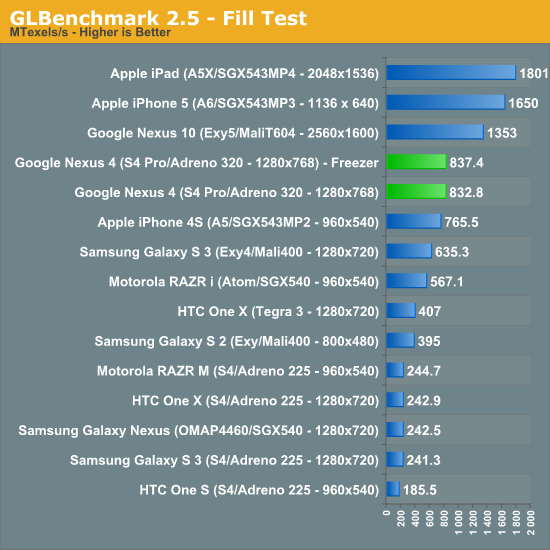
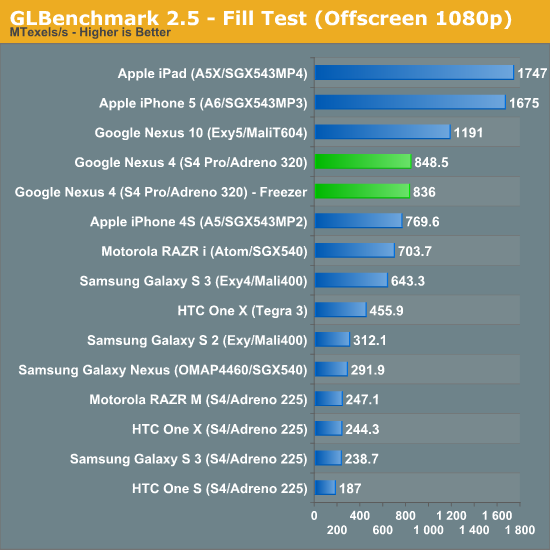
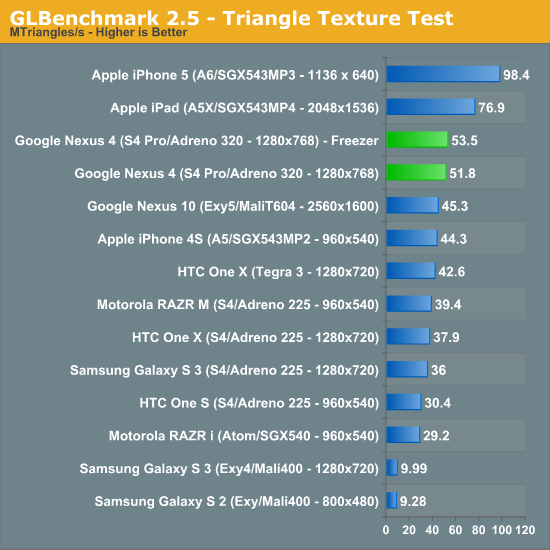
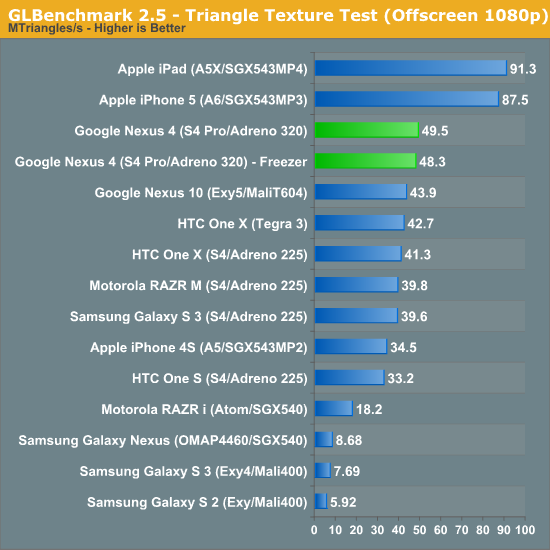
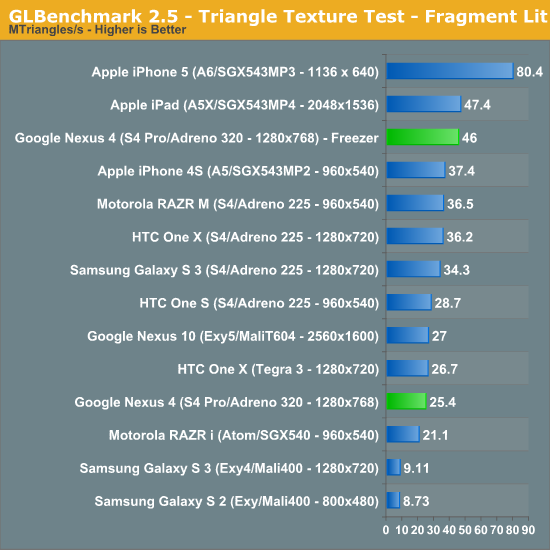
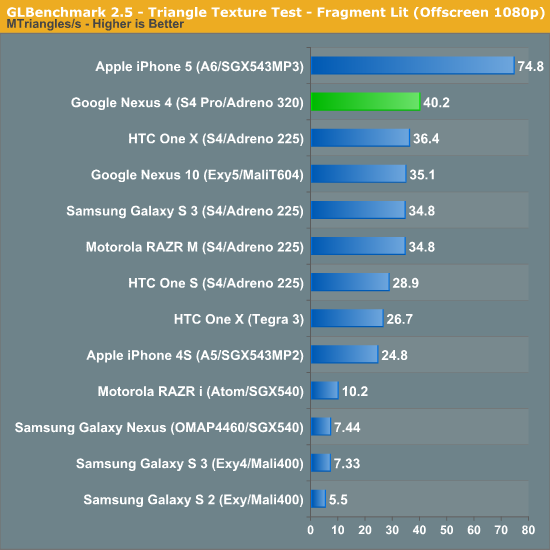
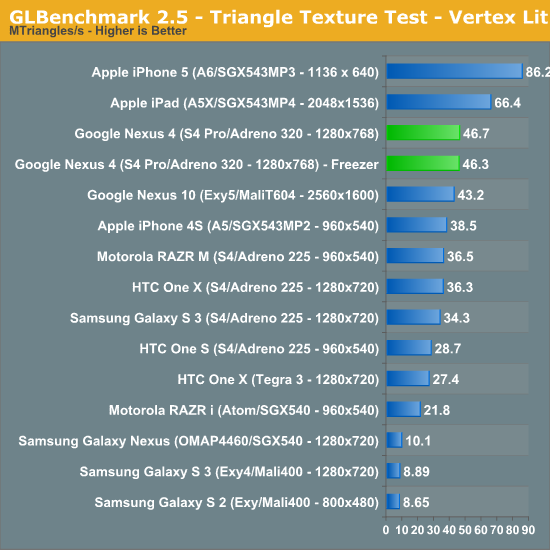
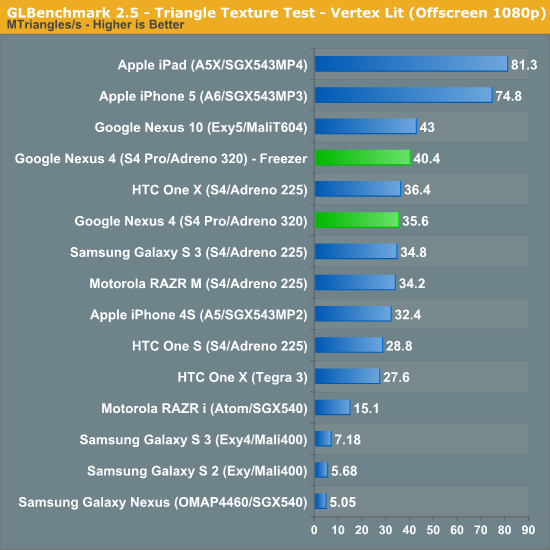
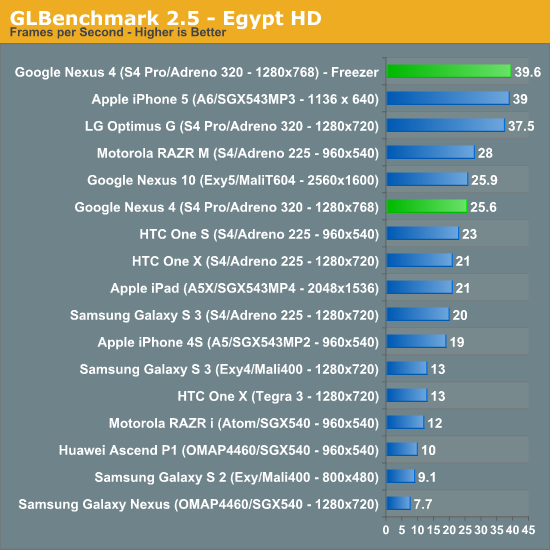
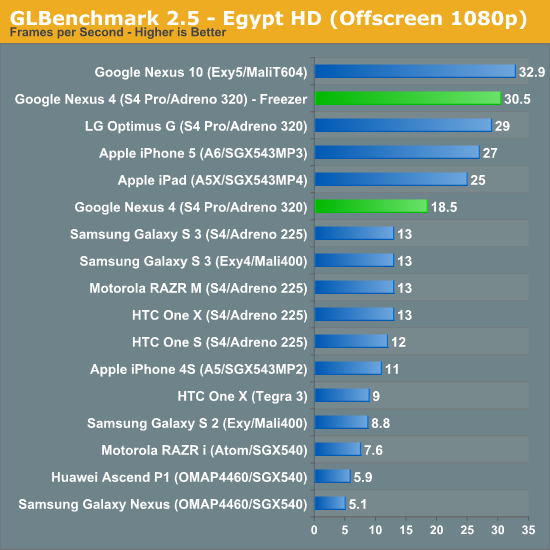
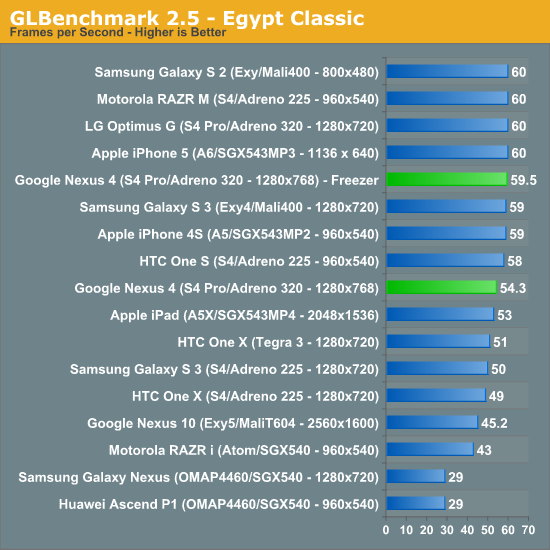
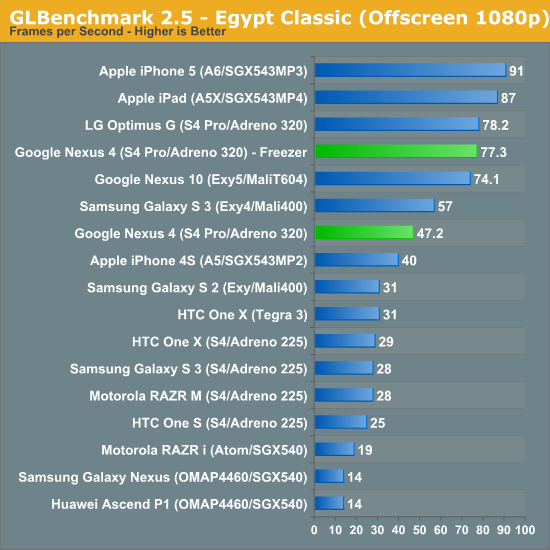
The result of the tests in the freezer results that are much closer to what we'd expect based on the APQ8064 MDP/T runs and the Optimus G numbers I saw in Korea.
When it comes to the CPU side of things there were results also affected by thermal throttling. I spaced some of those runs out (unintentionally) enough that performance didn't change, but for other things it did affect performance. I can't tell what GPU clocks end up being when the SoC decides to throttle, but it is possible to nail down what CPU performance state APQ8064 settles down into when there's throttling going on by looking at the state tables.

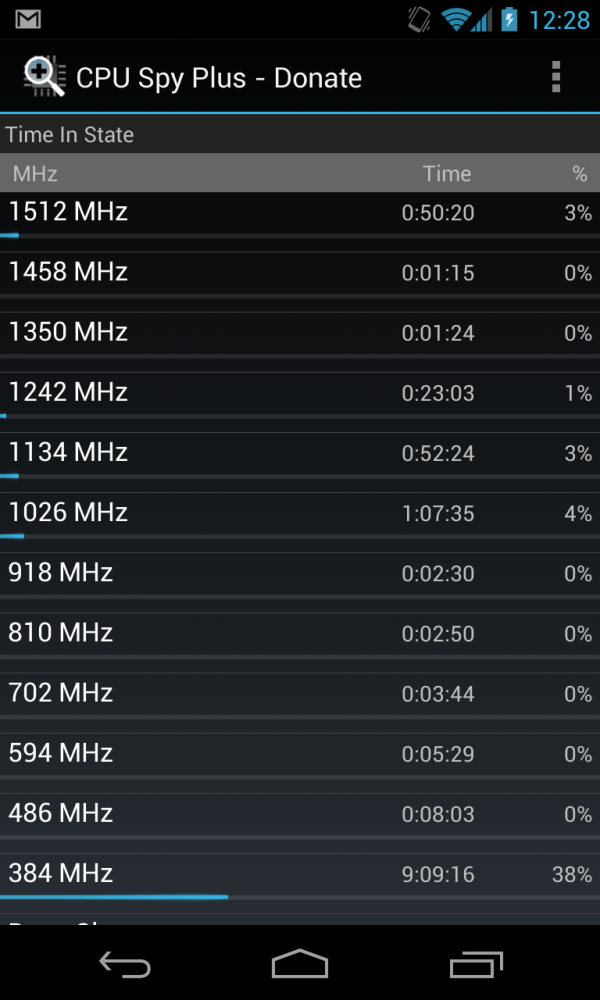
Left - 1.134 GHz during throttling (running tests), Right - All the performance states
I can see the Nexus 4 not use any of the performance states above 1134 MHz when it's getting hot, as shown in the images above. I've tweeted a link to the pastebin for thermald.conf which I believe configures the thermal cutoffs and will be interesting to kernel hackers trying to play with these values.
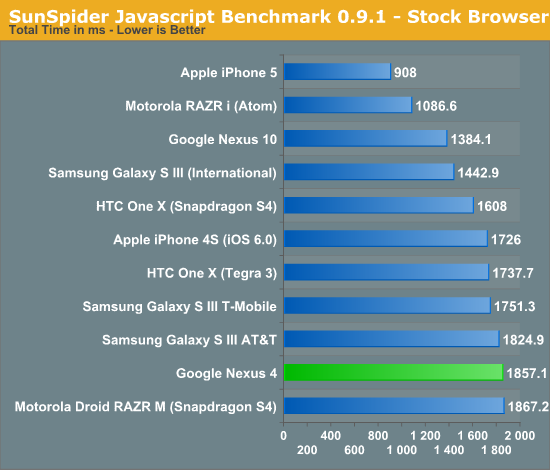
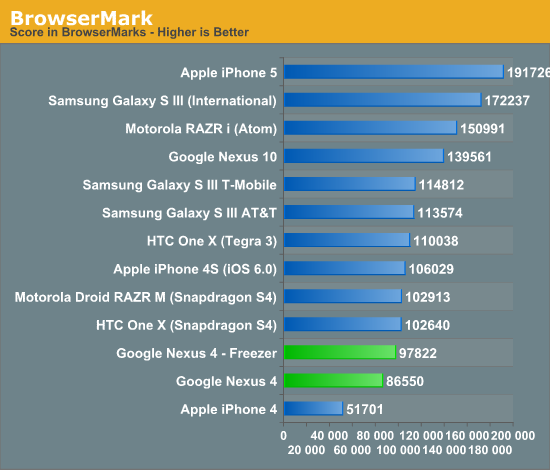
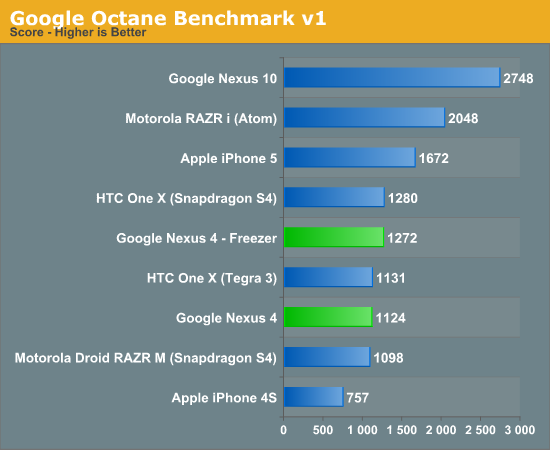
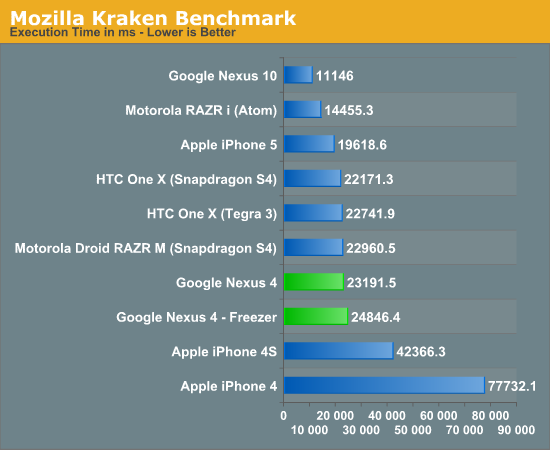
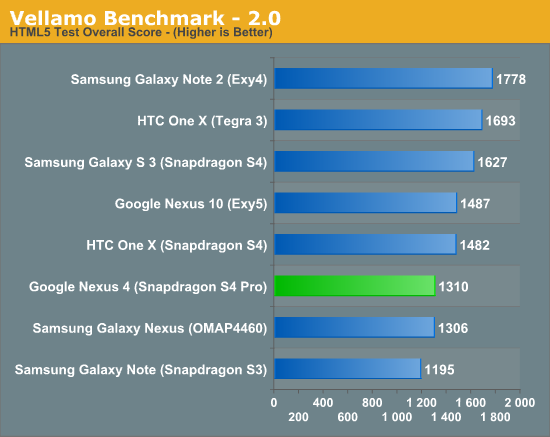
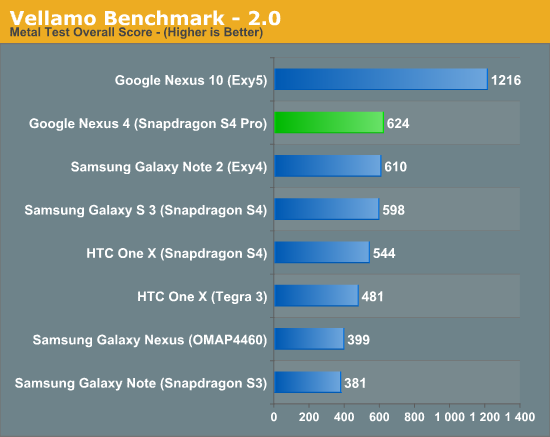
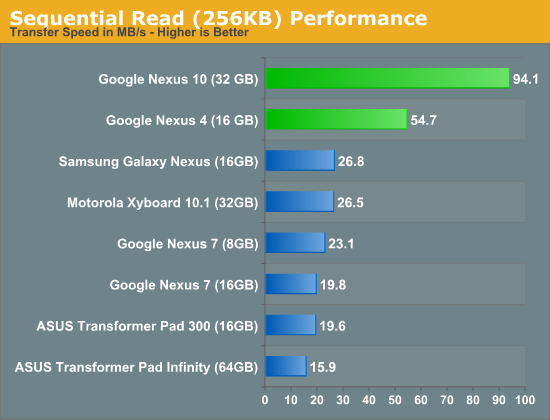
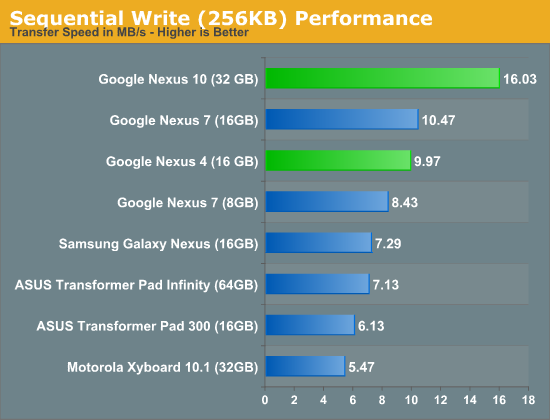
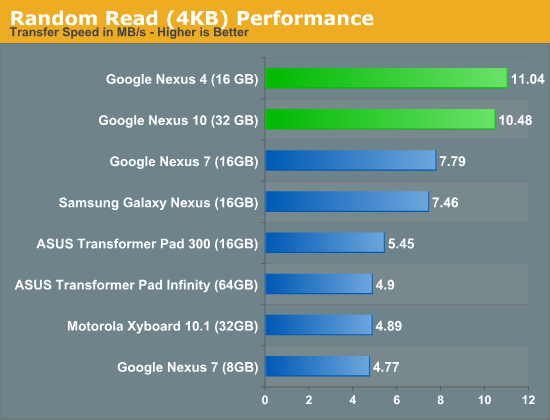
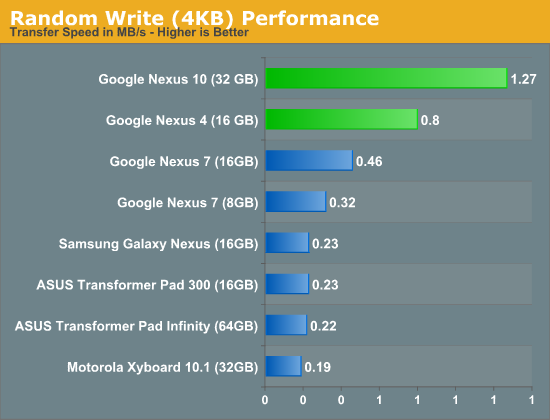
Our CPU performance side is unfortunately still dominated by JavaScript performance tests. The story there is that the Nexus 4 ships with Chrome (and originally shipped with a newer build of Chrome than what was on the market - we were running that updated version all along) and thus the mainline version of the V8 JavaScript engine. OEMs perform their own optimizations to the V8 library, and try to upstream whatever they can into the main project, but in the case of Chrome for Android that means V8 sans secret OEM sauce.










188 Comments
View All Comments
IKeelU - Tuesday, November 13, 2012 - link
I'm glad you confirmed the thermal throttling hypothesis, but it's a shame that it's happening at all. While no Google or LG exec is going to come out and tell everyone to use their phone in the cold, I see this turning into the Android version of the "your holding it wrong" meme. Perhaps Google should ship some capacitative gloves so Canadians and Scandinavians can enjoy their phones under ideal conditions ;P?Also, battery performance. It's half the iPhone 5's. Half.
Given the price and the nexus pedigree, I'm still going to buy this phone, warts and all. But the performance of the device in browsing and battery life is terribly disappointing.
amdwilliam1985 - Tuesday, November 13, 2012 - link
Again with the best test. It is not half in real life, trust me.we did real life test comparison with SGS3 and a new iphone 5, and I can see my S3 doing really well.
tuxRoller - Tuesday, November 13, 2012 - link
That suggests that the tests are not very useful.Frankly, I really like the idea of Vellamo. Testing interface performance is really useful.
The web browsing test might also be useful if it is well done (not sure if enough time is provided between page loads to actually read the page).
Perhaps use of a framework that takea actual apps and feeds them dummy data to simulate usage.
Testing is hard...
SetiroN - Tuesday, November 13, 2012 - link
The one time they could have gone with a slighly out of date SoC (the MSM8960 with its more efficient integrated baseband, or possibly the PRO) they didn't... ending up with a very power hungry platform that throttles and barely has enough battery life. Personally, I think I will disable two of the cores, but it's very appreciable that they're moving faster than before. I was really hoping for an OMAP5 (the first BIG.little A15 implementation) in the next nexus phone, obviously a few months from now, but I'll make do with the S4.It is, as usual, great how google keeps an eye on NAND performance, it really is a bottleneck in modern smartphones. Hopefully something better than 0.8MB/s random writes will be available in the near future... yes, it's 3 times faster than the competition, but still too low. We need 4/5.
I'm quite a bit against all this "high build quality" (which is apparently all about non-plastic materials) trend: not that I don't like better built phones, but plastic is FINE. It just has to be properly used, avoiding tacky chrome and glossy parts: the upside of having a lighter chassis with a removable door, and thus a repleaceble battery (which can probably be larger thanks to the spared weight) largely overcomes the improved aesthetics. Not to mention it's much less prone to serious damage as it manages to absorbs impacts well.
A glass back might be cool, but I won't notice it anymore after a week... until it breaks.
The real problems are Korean designers, not plastic materials.
In the end, higher battery life and storage space would have been much better, but at this price I won't complain, there's nothing even nearly as good. Heck, even $200 more would have been fair - and still cheaper than the competition.
Still, such a non-replaceable low lasting battery can and will be a dealbreaker to many just as much as the lack of storage. But the price is good enough to make me come to a compromise, disable 2 cores in the kernel and start carrying around a portable charger and OTG cable.
I wonder if anyone will make a nice battery cover with integrated storage :)
MTWeg12 - Tuesday, November 13, 2012 - link
Such an elaborate review. Awesome! It is nothing less than a PhD thesis.VivekGowri - Tuesday, November 13, 2012 - link
I think you seriously underestimate how long most PhD theses are. This could probably easily double as an engineering undergrad senior/final project though, as could many of our more in-depth reviews.Red Oak - Tuesday, November 13, 2012 - link
You don't point out that the iPhone 5 destroys it in your performance tests. On some, 100%+ faster. Pretty shocking, considering the Nexus has the latest four core variantThis phone is already a half step behind and has little headroom. Surprised Google would make this their flagship for the next year
amdwilliam1985 - Tuesday, November 13, 2012 - link
too bad iphone 5 is old news already, get ready for the incoming iphone 5S expected early 2013.Zink - Tuesday, November 13, 2012 - link
I think what we're all really getting ready for is the Razr Nexus 4 coming out in a year. Super thin with A15, improved battery life, 32GB and LTE.PeteH - Tuesday, November 13, 2012 - link
Maybe you are, but I won't be satisfied until I have a 64-bit ARMv8 in my phone!